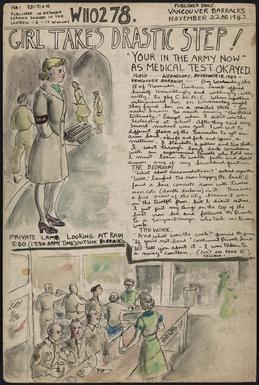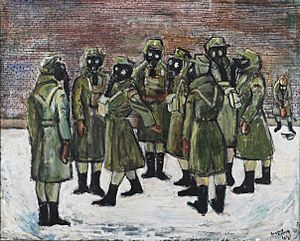Molly Lamb Bobak facts for kids
Molly Lamb Bobak (born Molly Lamb; February 25, 1920 – March 2, 2014) was a talented Canadian artist. She was a teacher, writer, printmaker, and painter. Molly used both oil paints and watercolours in her art.
During World War II, Molly made history. She was the first Canadian woman artist sent overseas. Her job was to draw and paint what Canada's soldiers were doing. She especially focused on the work of the Canadian Women's Army Corps (C.W.A.C.). This made her one of Canada's official war artists.
Contents
Life and Art Career
Growing Up and Early Art
Molly Lamb was born on February 25, 1920, in Vancouver, British Columbia. She grew up in a unique family home. Her father, Harold Mortimer-Lamb, was a mining engineer and art critic. He was friends with famous artists like the Group of Seven. These artists sometimes visited Molly's family.
Molly didn't always do well in school. She had poor eyesight and didn't like her teachers. But her mother saw her artistic talent. She encouraged Molly to study at the Vancouver School of Art. There, Molly learned from artist Jack Shadbolt. He became a lifelong friend and mentor. Shadbolt helped her discover amazing European artists like Cézanne and Matisse.
Becoming a War Artist
In 1942, Molly joined the Canadian Women's Army Corps (C.W.A.C.). She stayed for four years. This was a big chance for her to travel and learn new things. She traveled all over Canada. After Victory in Europe Day, she went to London, England. There, she met her future husband, artist Bruno Bobak. As part of the C.W.A.C., Molly was asked to draw and paint army life. She documented training, marching, and other war efforts.
From the start of her army time, Molly kept a special diary. It shows what C.W.A.C. life was like during the war. Her diary covers November 1942 to September 1945. Her drawings and funny comments make the diary very entertaining. It looked like a newspaper with handwritten notes and letters.
Molly made the diary for herself. But artist A. Y. Jackson saw her talent in it. He felt it showed she could be a great war artist. Today, the diary gives us a special look into a woman's experience in the Second World War army. Three years after she joined, Molly was chosen. She became Canada's first female official war artist. Some of her sketches, like "Gas Drill, Vermilion," were early ideas for her painting Gas Drill (1944). This painting is now at the Canadian War Museum.
One of Molly's most important war artworks is Private Roy (1946). This painting shows Sergeant Eva May Roy. It is one of the few pictures of Canadian soldiers of color from the war art program.
In 1992, a book called Double Duty: Sketches and Diaries of Molly Lamb Bobak Canadian War Artist was published. It included her wartime diaries and sketches. The diary was unique because it was set up like a newspaper. It had headlines, interviews, and even editorials. In 2015, Library and Archives Canada put all 226 pages of her diary online. This was to mark 70 years since she became Canada's only official woman war artist.
After the War
After the war ended, Molly and Bruno Bobak had a son named Alex. They tried to make a living on the West Coast. They painted, taught, and did other jobs. Molly didn't paint much during these years. She was busy raising her children and teaching art at night.
However, she met Jacques Maritain, a French philosopher. He was very impressed by her art. He helped her get a scholarship from the French Government. This allowed her to visit France.
Alan Jarvis, who directed the National Gallery of Canada, also liked her work. He invited her to show her art in big exhibitions. These included the Sao Paulo Biennial and the Vancouver Art Gallery's Third Canadian Biennial in 1960. Through these shows, Molly became more famous and earned more money from her art. She was one of the first Canadian women artists to work professionally and earn a living from her art.
Life in Fredericton
Molly and Bruno spent four years in Europe with money from the Canada Council. Then, Bruno was offered a teaching job. It was at the University of New Brunswick in Fredericton, New Brunswick. Bruno and Molly moved to Fredericton, and Molly continued to live there.
In 1973, she became a member of the Royal Canadian Academy of Arts. In 1993, the MacKenzie Art Gallery in Regina, Saskatchewan held a big show of her work. This show traveled to different places.
Molly Bobak is best known for her paintings of crowds of people. Her art always shows lots of energy. Her work from World War II is also very famous. Her crowd paintings show public events and many people sharing the same space. They capture the feeling of celebration. Molly saw these paintings as an artistic challenge. She loved showing the changing rhythm of large groups of people.
Art Collections
Molly Bobak's art can be seen in important collections. These include the National Gallery of Canada and the Musée national des beaux-arts du Québec. Library and Archives Canada also keeps many of her personal records. These include prints, drawings, watercolours, and photographs.
Awards and Honours
Molly Bobak received many awards for her art and service:
- Canadian Army Art Competition, 1944.
- First prize, Graphic Art Society, 1966.
- French Government scholarship for study in France, 1950–51.
- Canada Council fellowship for study in Europe, 1960–61.
- Order of Canada, 1995.
- Order of New Brunswick, 2002.
Later Life
Molly Bobak passed away on March 2, 2014. During World War II, there were 32 official war artists. Molly was the last one of them still alive.
See also
 In Spanish: Molly Bobak para niños
In Spanish: Molly Bobak para niños
- Canadian official war artists
- War artist
- Military art




